In terms of Virtual machine, a different workstation platform using multiple operating systems can be expensive if you want to work with both Windows and Linux. That’s because you may need an extra hard drive to support both of your OS. Besides, not everyone can afford two PC for their separate works, right? But if you are using Windows 10 OS on your computer, then things can go in a different way, how? Because you don’t need an extra hard drive or even a third-party software to run a virtual machine. Sound interesting, right? That’s why today we are going to learn a simple way to create a virtual machine on Windows 10 without using third party software in this article.
Windows 10 has built-in official tools called Hyper-V, which is known as the best virtual machine for Windows 10 users. Hyper-V runs it’s each virtual machine on its own space – which means you can host several OS virtually on the same hardware inside your single OS on your computer. Likewise, you can establish your own private cloud environment, improve your business continuity, manage your desktop application and data security, and more.
So whether you are planning to run Linux or just want to manage your other important software and make them private from other, Hyper-V can be a great deal for Windows 10 users. So worry not if you don’t know how to create a Virtual Machine in your Windows 10. That’s why we are here for you to give complete guidance about creating a virtual machine.
Make sure you head through the whole article in order to successfully create a virtual machine in Windows 10 without using third-party software. But before moving into our main topic, let’s be more clear about the Virtual machine and what benefits we get from using it?
What is a Virtual Machine?
A virtual machine is like a computer system that has its own CPU, memory, network interface, and storage. It’s like a one set of physical resource which has a separate partition within a same operating system. Though it cannot be considered as the real system, that’s why we called it as a virtual machine.
A virtual machine is like a server which can be moved between the host servers to effectively utilize the use of resources. End users can experience the real-time operating system, which is running in a physical machine. Besides, if you use the virtual machine, then you can also test a new application without hurting the real OS. So,
Now, let’s talk about the benefits of why so many people choose the virtual machine.
Benefits of Virtual Machine in Computer
You might be wondering why use the virtual machine in a single OS and what benefits people can get from it? Till now, we have a clear idea that the virtual machine lets us use multiple operating systems in a single computer. Besides, it also has a good purpose, which keeps attracting Windows users. So, let’s take a look at the benefits one by one down below.
Virtualization
Virtualization means that creating a virtual environment where people can work just like in a real-time. In other words, it a kind of new reproduction of hardware in a digital manner. Users can get a more flexible workspace where they will work with virtual hardware rather than traditional. So, the virtual machine reduces the cost of additional hardware by providing access to the virtual environment.
New Operating System
Users can able to enjoy the additional new OS inside the same computer. They don’t have to buy a new PC or laptop to use the two different OS for their work. A new operating system means that you can run both Windows and Linux simultaneously. You can test your new software and application inside your new OS, which is a safe and reliable method. Plus, you can also keep your valuable data and information private from others to keep it safe.
Check Doubtful Files
In the real-time scenario, we are told that we should not open any suspicious file and folder which can harm our system. But in the case of a virtual machine, you can easily break the rule and can access unknown files or attachments. You can fully check the doubtful file, and in case it breaches any security, then it’s only with the virtual environment. In other words, it cannot harm your real operating system. So that’s the best part of using the virtual machine on your computer.
Can Run Old and Incompatible Software
If you use the virtual machine, then you can even run and test the old and incompatible software which is not supported by the Windows apps. You might have heard about the Ubuntu – their apps can’t run in the Window, but if you use the different older versions of Windows inside the virtual machine, you can easily access the apps without any issues.
So, it’s the best way to run and check the old app in the virtual machine rather than using third-party software. Even though you use third-party software, you cannot enjoy the app’s actual features.
Easy Recover
The recovery process of the virtual machine is quite easy, simple, and helpful. Though you can only backup one VM at a time, still offer the best recovery method. Users can quickly restore the lost file without causing any errors.
Hardware Requirements for Hyper-V Virtual Machine
Hyper-V is a virtualization technology that lets the Windows 10 user run multiple virtual machines in a single computer. Only having a correct Windows 10 installation in your PC is not enough to run the Hyper-V. You also have to look at your hardware, whether your system can handle the Hyper-V or not. So here’s a hardware requirement for the Hyper-V in Windows 10.
- Minimum 4GB memory
- 64-bit CPU along with Second Level Address Translation (SLAT)
- VM Monitor Mode Extension support processor
Verify Whether Your Windows 10 Computer Have a Hyper-V
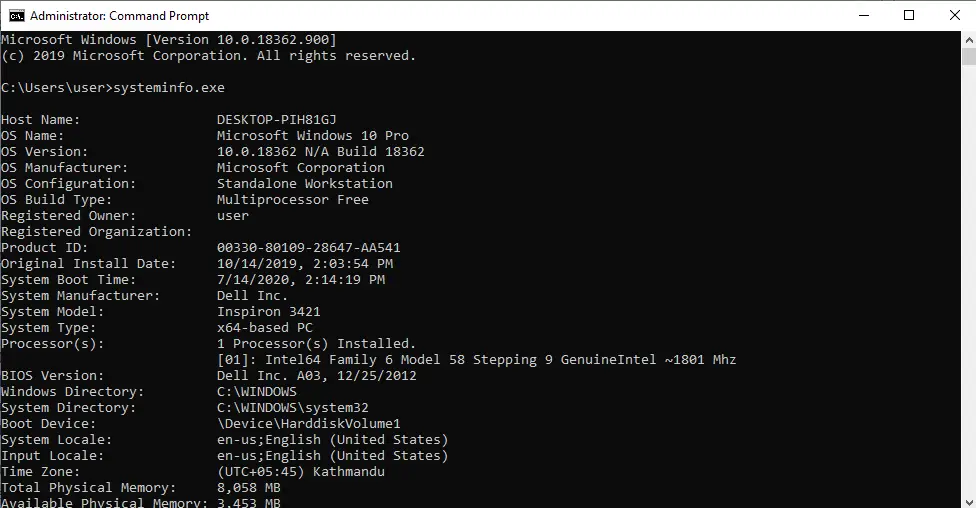
Here you can check whether your PC has a Hyper-V or not. If you can’t find the Hyper-V virtualization, then you cannot create a virtual machine on your computer. The result, you have to install the third-party software to run the Virtual machine in your Windows 10.
Usually, most of the Windows 10 PC has a Hyper-V, but some time due to old version you can’t have a Hyper-V – means your PC doesn’t support Hyper-V. So, let’s verify with the help of Command Prompt down below.
- Press the Windows key in your keyboard and then type command prompt.
- Now, open your CMD through the run as administrator.
- On the CMD screen type systeminfo.exe.
- So, if you can see “Yes” under the Hyper-V requirements, then your PC can easily run the Hyper-V. But, if a command says “No” then your Windows 10 computer doesn’t support the Hyper-V feature.
Now, if your PC supports the Hyper-V, then it’s time to enable or run the Hyper-V in your Windows 10.
How to Create a Virtual Machine in Windows 10
Now, it’s time to create a virtual machine in Windows 10 after learning a little bit about the virtual machine and its benefits. As I already told you, we are using the Hyper-V tool instead of the third-party software to create a virtual machine. Besides, you can also use third-party software if you want, as there is no restriction. But be sure to get trustworthy software which does not harm your computer.
Okay, for now, let’s move to the simple procedure to create a virtual machine on Windows 10 without using any other software in 2022.
Enable the Hyper-V Tool

- First thing first, go to the Windows search bar, which is located at the bottom left side of the screen.
- Now, type Turn Windows Features and then click on that menu. Alternatively, you can also open the run dialog and type optionalfeatures.exe, which will directly open the turn windows features on and off-menu.
- After that, check on the Hyper-V option in order to enable the tools in your Windows 10.
- Click on the Ok button to save the changes. Once you are done, restart your computer to finish the installation process.
After restarting your computer, you can find that Hyper-V is now enabled. Now the next step is to create a virtual switch in order to connect the VM to the internet. So, let’s get back to the steps again down below.
Create a Virtual Switch
- First, press the Windows button and then type Hyper-V, where you will see the Hyper-V Manager desktop app. So open the Hyper-V Manager app.
- Select your Desktop user name.
- Now, under the Action menu, choose the Virtual Switch Manager.
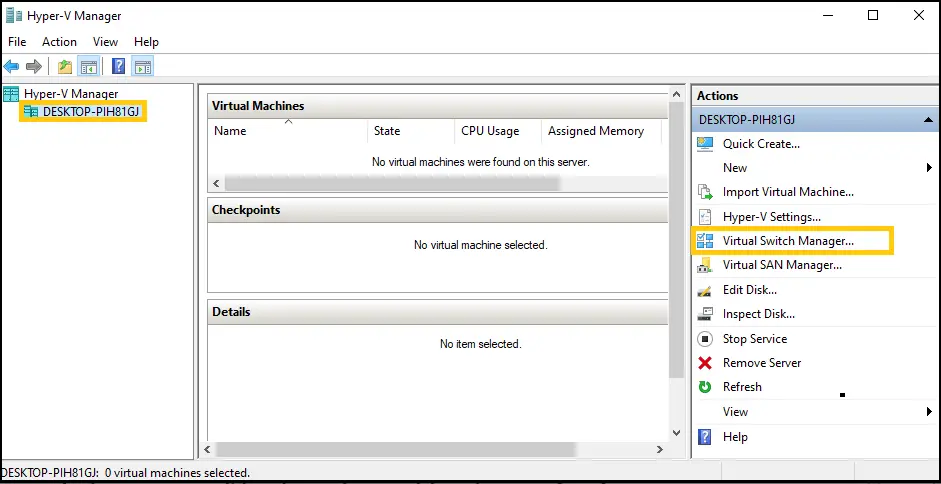
- After that, select the External and then click on the Create Virtual Switch option.
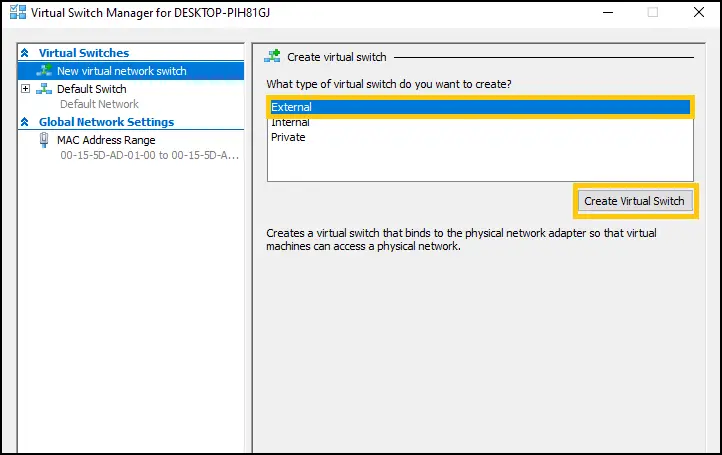
- Now, provide any name and notes (e.g., name= Windows Virtual switch).
- Under the Connection type, select the External Network option and finally click on the Ok button.
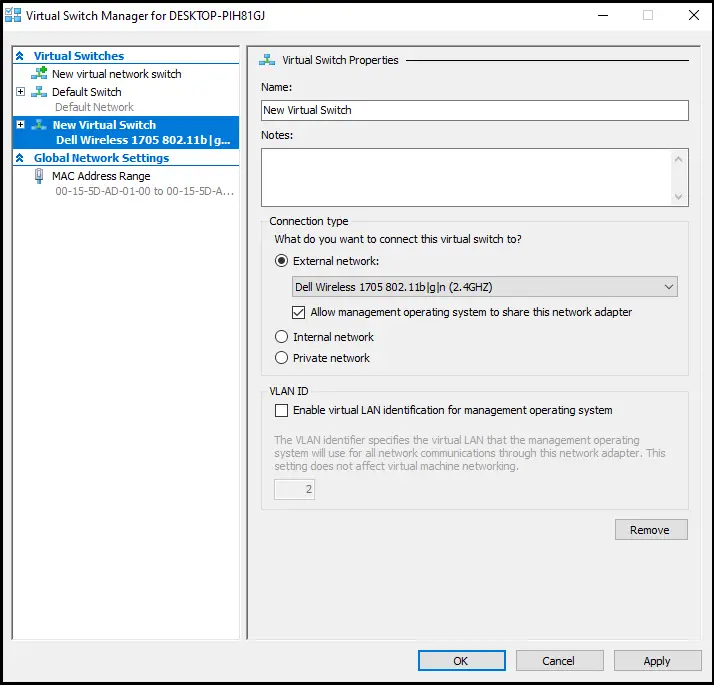
So, you have successfully created a virtual switch inside the virtual machine. You might be wondering why created a virtual switch? That’s because it provides an extra level of security or protection between the virtual machines. Let’s say it’s like a safeguard or body armor which protects you in case something goes wrong.
After that, you have to create a new virtual machine.
Create a New Virtual Machine
- Under the Action menu on your desktop name, click on the New button and then select Virtual Machine.
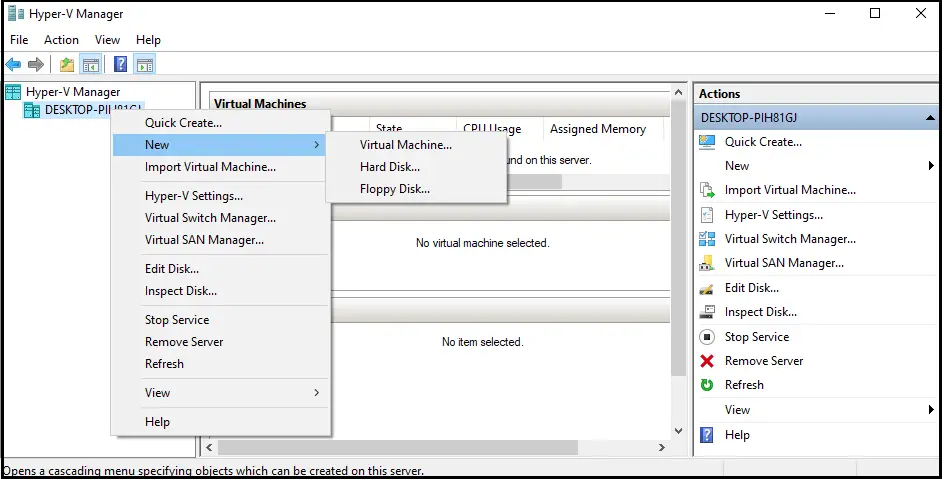
- Now you have to set up your virtual machine. So you need to provide few information to set up the new virtual machine such as:
Specify Name and Location
Specify Generation
Assign Memory
Configure Networking
Connect to Virtual Hard Disk
Pick the Installation Option
Summary - Your setup steps depend on how you customize your virtual machine installation. So just follow the steps to successfully create a new virtual machine (Hyper-V) on your computer. Once you have done, click on the Next button for further process.
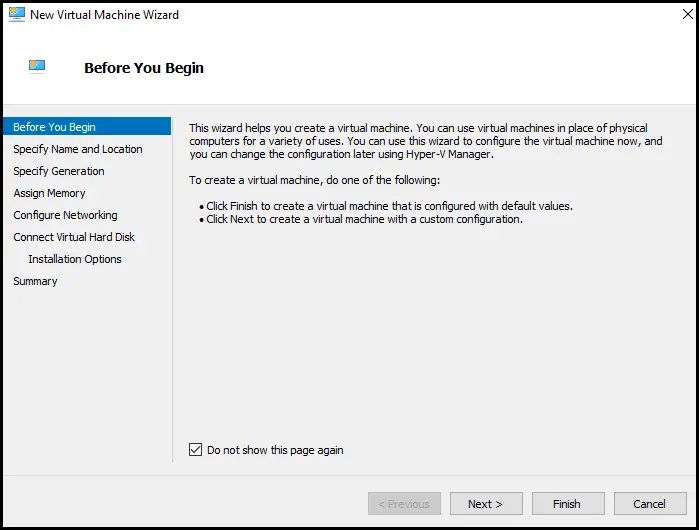
- Now, you have to choose to install an operating system from a bootable image file under the installation option.
- After that, choose the IOS file on which operating system you want to create, and you are done.
Is Windows Virtual Machine Free?
Yes, you can use the free windows virtual machine like Hyper-V on your computer. If you are new and introducing yourself in the world of the virtual machine then I recommend using free VM. After working a few years on a virtual machine then you can try other professional virtual machine applications such as VMWare Workstation Pro, Parrell Desktop, Virtual Box, Kernal Based VM, VMWare Fusion.
Conclusion
So now, you have a clear idea of how to create a virtual machine on Windows 10 without using third-party software. All you have to follow the above-mentioned steps to quickly set up a Hyper-V virtual machine on your computer. Now it’s your decision whether you want to run a Linux or to test an application in your virtual machine.
Was this article helpful to create a virtual machine in your Windows 10 PC? Let us know in the comment section down below. Also if you have any queries regarding the article, then don’t hesitate to leave a comment.





